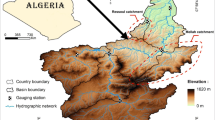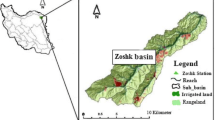Abstract
Sediment load estimation is essential in many water resources projects. In this study, the capability of two different types of model including SWAT as a process-based model and ANNs as a data-driven model in simulating sediment load were evaluated. The issue of uncertainty in the simulated outputs of the two models which stems from different sources was also investigated. Calibration and uncertainty analysis of SWAT were performed using monthly observed discharge and sediment load values and through the application of SUFI-2 procedure. The issue of uncertainty in the ANN model was also accounted for by training a network several times with different initial weights and bias values as well as randomly-selected training and validation sets, each time a network trained. Trying different input variables to find the best and most efficient network structure, it was found that in the forested watershed of Kasilian, adding average daily rainfall or previous values of discharge dose not change the performance of the ANN model significantly. Comparing the results of SWAT and ANN, it was found that SWAT model has a superior performance in estimating high values of sediment load, whereas ANN model estimated low and medium values more accurately. Moreover, prediction interval for the results of ANN was narrower than that of SWAT which suggests that ANN outputs are with less uncertainty.
Similar content being viewed by others
References
Abbaspour KC (2008) SWAT-CUP user manual. Federal Institute of Aquatic Science and Technology (Eawag), Swiss
Abbaspour KC, Johnson A, van Genuchten MTh (2004) Estimating uncertain flow and transport parameters using a sequential uncertainty fitting procedure. Vadose Zone J 3(4):1340–1352
Abbaspour KC, Yang J, Maximov I, Siber R, Bogner K, Mieleitner J, Zobrist J, Srinivasan R (2007) Modelling hydrology and water quality in the pre-alpine/alpine Thur watershed using SWAT. J Hydrol 333(2–4):413–430
Abrahart RJ, White SM (2001) Modelling sediment transfer in Malawi: comparing backpropagation neural network solutions against a multiple linear regression benchmark using small data sets. Phys Chem Earth, Part B Hydrol Oceans Atmos 26(1):19–24
Anctila F, Michelb C, Perrinb C, Andreassianb V (2004) A soil moisture index as an auxiliary ANN input for stream flow forecasting. J Hydrol 286(1–4):155–167
Aqila M, Kitab I, Yanob A, Nishiyamac S (2007) Analysis and prediction of flow from local source in a river basin using a Neuro-fuzzy modeling tool. J Environ Manag 85(1):215–223
Barsanti A, Disperati L, Marri P, Mione A (2003) Soil erosion evaluation and multi-temporal analysis in two Brazilian basin. In: 2th international SWAT conference, Bari, Italy, 1–4 July 2003
Beven K, Binlley A (1992) The future of distributed models: model calibration and uncertainty prediction. Hydrol Process 6(3):279–298
Chekol DA, Tischbein B, Eggers H, Vlek P (2007) Application of SWAT for assessment of spatial distribution of water resources and analyzing impact of different land management practices on soil erosion in upper awash river basin watershed, FWU Water ResourcesPublications. Volume No: 06/2007, ISSN No. 1613–1045. pp 110–117
Cigizoglu HK, Kisi O (2006) Methods to improve the neural network performance in suspended sediment estimation. J Hydrol 317(3–4):221–238
Dawson CW, Abrahart RJ, Shamseldin AY, Wilby RC (2006) Flood estimation at ungauged sites using artificial neural networks. J Hydrol 319(1–4):391–409, Eng., ASCE 127(1):30–37
Demirel MC, Venancio A, Kahya E (2008) Flow forecast by SWAT model and ANN in Pracana basin, Portugal. Adv Eng Softw 40(7):467–473
Farokhnia A, Morid S (2009) Uncertainty analysis of artificial neural networks and nero-fuzzy models in river flow forecasts. Iran J Water Resour Manag (in press)
Heskes T (1997) Practical confidence and prediction interval. In: Mozer M, Jordan M, Peskes T (eds) Advances in neural information processing systems 9. MIT, Cambridge, pp 466–472
Hornik K, Stinchcombe M, White H (1990) Universal approximation of an unknown mapping and its derivatives using multi layer feedforward networks. Neural Netw 3:551–560
Hsu KL, Gupta H, Sorooshian S (1995) Artificial neural network modeling of the rainfall runoff process. Water Resour Res 31(10):2517–2530
Jacobs JH, Srinivasan R (2005) Application of SWAT in developing countries using readily available data. In: 3th international SWAT conference, Zurich, 11–15 July 2005
Jain SK (2001) Development of integrated sediment curve using ANNs. J Hydro 127:30–37
Kool JB, Parker JC (1988) Analysis of the inverse problem for transient unsaturated flow. Water Resour Res 24(6):817–830
Kuczeraa G, Parent E (1998) Monte Carlo assessment of parameter uncertainty in conceptual catchment models: the Metropolis algorithm. J Hydrol 211(1–4):69–85
Luk KC, Ball JE, Sharma A (2000) A study of optimal model lag and spatial inputs to artificial neural network for rainfall forecasting. J Hydrol 227(1–4):56–65
Maier HR, Dandy GC (2000) Neural networks for the prediction and forecasting of water resources variables: a review of modeling issues and applications. Environ Model Softw 15(1):101–124
Marce’ R, Comerma M, Garcia JC, Armengol J (2004) A neuro-fuzzy modeling tool to estimate fluvial nutrient loads in watersheds under time-varying human impact. Limnol Oceanogr 2(1):342–355
McKay MD, Beckman RJ, Conover WJ (1979) A comparison of three methods for selecting values of input variables in the analysis of output from a computer code. Technometrics 21:239–245
Michael W, van Liew, Arnold GJ (2005) Downstream sediment response to conservation practice implementation. In: 3th international SWAT conference, Zurich, 11–15 July 2005
Mishra A, Kar S, Singh VP (2007) Prioritizing structural management by quantifying the effect of land use and land cover on watershed runoff and sediment yield. Water Resour Manag (2007) 21(11):1899–1913
Morid S, Gosain AK, Keshari AK (2002a) Comparison of the SWAT model and ANN for daily simulation of runoff in snowbound ungauged catchments. In: Fifth international conference on hydroinformatics, Cardiff
Morid S, Gosain AK, Keshari AK (2002b) Solar radiation estimation using temperature-based, stochastic and artificial neural networks approaches. Nord Hydrol 3(4):291–304
Ndomba PM, Mtalo FW, Killingtveit (2007) A Sediment yield mdeling using SWAT at larger and complex catchment: issues and approaches. A case of Pangani River catchment, Tanzania. In: 4th international SWAT conference, institute for water education Delf, The Netherlands, pp 4–6
Neitsch SL, Arnold JG, Kiniry JR, Williams JR (2005) Soil and water assessment tool theoretical documentation version 2005. BlackLand Research Center
NRC (2001) Assessing the TMDL approach to water quality management. Committee to access the scientific basis of the total maximum daily load approach to water pollution reduction, water science and technology board, division on earth and life studies, national research council, Washington, DC
Ozturk F, Apaydin H, Walling DE (2001) Suspended sediment load through flood events for streams of Sakarya Basin. Turkish J Eng Env Tubitak 25:643–650
Panagoulos Y, Polyzoi E, Mimikou M (2007) Land use change effect on river sediment yield in Western Greece. In: 4th international SWAT conference, institute for water education Delf, The Netherlands, 4–6 July 2007
Rai RK, Mathur BS (2008) Event-based sediment yield modeling using artificial neural network. Water Resour Manag 22(4):423–441
Tayfur G (2002) Artificial neural networks for sheet sediment transport. Hydrol Sci J 47(6):879–892
van Griensven A, Meixner T (2007) A global and efficient multi-objective auto-calibration and uncertainty estimation method for water quality catchment models. J Hydroinform 9(4):277–291
Vrugt JA, Gupta HV, Bouten W, Sorooshian S (2003) A shuffled complex evolution metropolis algorithm for estimating posterior distribution of watershed model parameters. In: Duan Q, Sorooshian S, Gupta HV, Rousseau AN, Turcotte R (eds) Calibration of watershed models. AGU, Washington, DC. doi:10.1029/006WS07
Willemsen PG, Bailer CAL, Kaempf TA (2004) ICAP-Variability-Alerts joint working group meeting, Paris, 8 October 2004
Williams JR (1975) Sediment routing for agricultural watersheds. Water Resour Bull 11(5):965–974
Wischmeier WH, Smith DD (1978) Predicting rainfall losses: a guide to conservation planning. USDA Agricultural Handbook No. 537. U.S. Gov. Print. Office, Washington, DC
Author information
Authors and Affiliations
Corresponding author
Rights and permissions
About this article
Cite this article
Talebizadeh, M., Morid, S., Ayyoubzadeh, S.A. et al. Uncertainty Analysis in Sediment Load Modeling Using ANN and SWAT Model. Water Resour Manage 24, 1747–1761 (2010). https://doi.org/10.1007/s11269-009-9522-2
Received:
Accepted:
Published:
Issue Date:
DOI: https://doi.org/10.1007/s11269-009-9522-2




